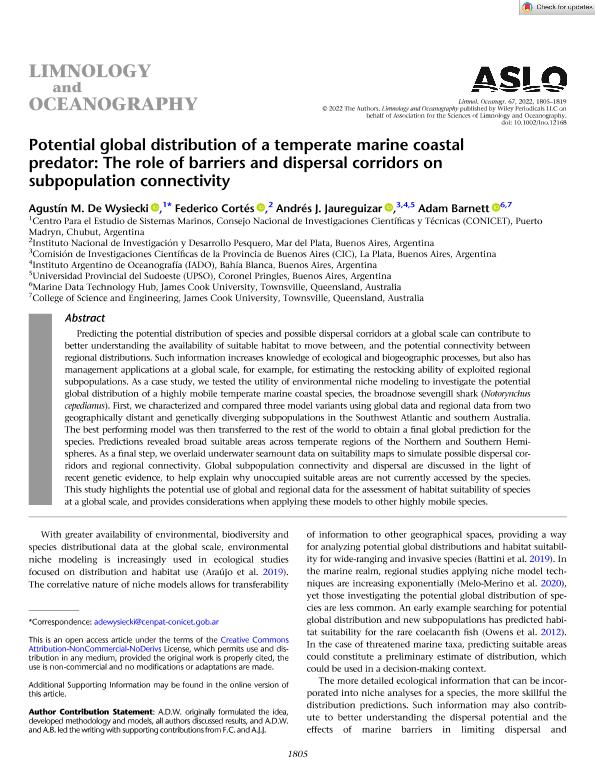Mostrar el registro sencillo del ítem
dc.contributor.author
de Wysiecki, Agustín María

dc.contributor.author
Cortés, Federico

dc.contributor.author
Jaureguizar, Andrés Javier

dc.contributor.author
Barnett, Adam
dc.date.available
2023-07-25T12:49:22Z
dc.date.issued
2022-06
dc.identifier.citation
de Wysiecki, Agustín María; Cortés, Federico; Jaureguizar, Andrés Javier; Barnett, Adam; Potential global distribution of a temperate marine coastal predator: The role of barriers and dispersal corridors on subpopulation connectivity; John Wiley & Sons; Limnology and Oceanography; 67; 8; 6-2022; 1805-1819
dc.identifier.issn
1939-5590
dc.identifier.uri
http://hdl.handle.net/11336/205232
dc.description.abstract
Predicting the potential distribution of species and possible dispersal corridors at a global scale can contribute to better understanding the availability of suitable habitat to move between, and the potential connectivity between regional distributions. Such information increases knowledge of ecological and biogeographic processes, but also has management applications at a global scale, for example, for estimating the restocking ability of exploited regional subpopulations. As a case study, we tested the utility of environmental niche modeling to investigate the potential global distribution of a highly mobile temperate marine coastal species, the broadnose sevengill shark (Notorynchus cepedianus). First, we characterized and compared three model variants using global data and regional data from two geographically distant and genetically diverging subpopulations in the Southwest Atlantic and southern Australia. The best performing model was then transferred to the rest of the world to obtain a final global prediction for the species. Predictions revealed broad suitable areas across temperate regions of the Northern and Southern Hemispheres. As a final step, we overlaid underwater seamount data on suitability maps to simulate possible dispersal corridors and regional connectivity. Global subpopulation connectivity and dispersal are discussed in the light of recent genetic evidence, to help explain why unoccupied suitable areas are not currently accessed by the species. This study highlights the potential use of global and regional data for the assessment of habitat suitability of species at a global scale, and provides considerations when applying these models to other highly mobile species.
dc.format
application/pdf
dc.language.iso
eng
dc.publisher
John Wiley & Sons

dc.rights
info:eu-repo/semantics/openAccess
dc.rights.uri
https://creativecommons.org/licenses/by-nc-nd/2.5/ar/
dc.subject
DISTRIBUTIONAL ECOLOGY
dc.subject
NICHE TRANSFER
dc.subject
SEAMOUNTS
dc.subject
SHARKS
dc.subject
SUITABILITY
dc.subject.classification
Biología Marina, Limnología

dc.subject.classification
Ciencias Biológicas

dc.subject.classification
CIENCIAS NATURALES Y EXACTAS

dc.title
Potential global distribution of a temperate marine coastal predator: The role of barriers and dispersal corridors on subpopulation connectivity
dc.type
info:eu-repo/semantics/article
dc.type
info:ar-repo/semantics/artículo
dc.type
info:eu-repo/semantics/publishedVersion
dc.date.updated
2023-07-10T10:38:26Z
dc.journal.volume
67
dc.journal.number
8
dc.journal.pagination
1805-1819
dc.journal.pais
Estados Unidos

dc.journal.ciudad
Nueva Jersey
dc.conicet.avisoEditorial
This is an open access article under the terms of the Creative Commons Attribution-NonCommercial-NoDerivs License, which permits use and dis tribution in any medium, provided the original work is properly cited, the use is non-commercial and no modifications or adaptations are made.
dc.description.fil
Fil: de Wysiecki, Agustín María. Consejo Nacional de Investigaciones Científicas y Técnicas. Centro Científico Tecnológico Conicet - Centro Nacional Patagónico. Centro para el Estudio de Sistemas Marinos; Argentina
dc.description.fil
Fil: Cortés, Federico. Instituto Nacional de Investigaciones y Desarrollo Pesquero; Argentina. Consejo Nacional de Investigaciones Científicas y Técnicas; Argentina
dc.description.fil
Fil: Jaureguizar, Andrés Javier. Consejo Nacional de Investigaciones Científicas y Técnicas. Centro Científico Tecnológico Conicet - Bahía Blanca. Instituto Argentino de Oceanografía. Universidad Nacional del Sur. Instituto Argentino de Oceanografía; Argentina. Provincia de Buenos Aires. Gobernación. Comisión de Investigaciones Científicas; Argentina
dc.description.fil
Fil: Barnett, Adam. James Cook University; Australia
dc.journal.title
Limnology and Oceanography
dc.relation.alternativeid
info:eu-repo/semantics/altIdentifier/doi/http://dx.doi.org/10.1002/lno.12168
dc.relation.alternativeid
info:eu-repo/semantics/altIdentifier/url/https://aslopubs.onlinelibrary.wiley.com/doi/10.1002/lno.12168
Archivos asociados
